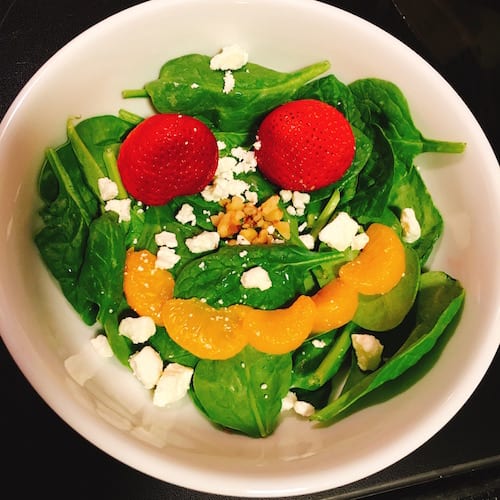In the past 16 years, I have been on a lot of different medications all of which have affected me differently. Some caused me to gain weight due to feeling hungry all the time and overeating, sometimes they caused me to retain water, and who knows what triggered weight gain with some of the others.
In addition to medications, time has taken a toll on my body, including having a baby and working a desk job while going to school (in other words, an excuse for not making time to work out). But eating also got out of hand I was eating fast food frequently because I was too time-crunched to cook. I was eating way too many sweets because, frankly, desserts make me happy or so I thought.
I also noticed that my eating patterns changed when my moods did. I would eat less when I was depressed and more when I was manic-y. I craved sweets all the time, but needed them when I was depressed for a quick pick-me-up.
One day, about nine months ago, I got sick of feeling like crap and eating like crap and feeling like I looked like crap. I was officially overweight and that made me even more depressed. I had teetered there for a while, but had never crossed the line before.
So I decided to make some intentional lifestyle changes to get myself on track. First, I started simply tracking everything I put into my mouth using a convenient app on my smartphone. I started in late August and by December had only gone over my allotted calories twice once on Thanksgiving (and only by a little!) and once because of a Christmas party (that had all of my favorite desserts). I lost 20 pounds just by watching how much I was putting in my mouth.
Beginning in the New Year, I decided that it wasnt enough to just eat less, I wanted to eat better, so I started watching WHAT I put into my mouth. I now have 6 different Pinterest Boards dedicated to yummy, healthy recipes one for healthy breakfasts, one for healthy entrees, one for healthy treats (of course!), and more. Every week I spend about an hour picking out recipes to try and I spend part of Sunday cooking and prepping for the week. The prepping makes a HUGE difference. I am more likely to eat healthfully when healthy foods are available. That is part of the reason convenience foods are so often consumed they are convenient! Now I keep things like sliced strawberries, washed apples, homemade energy bites (these chocolate ones or these pumpkin ones are two of my favorites), zucchini brownies (like these or these), flourless chocolate chip cookies, carrot slices, or some variation of goodies, prepped and ready to nibble on when I need a snack. And I make a lot of things on the George Foreman Grill basil and feta turkey burgers, honey mustard tuna steaks, any variety of chicken breasts, you get the idea! Spiralizing vegetables to use as noodles instead of pasta is also a great way to cut calories and increase vegetable intake and its so fast! For lunches, I love this recipe for buffalo ranch tuna salad (amazing on a low fat wrap) and this one for coconut chickpea sweet potato curry stew (which reheats like a champ). These are quick, easy and healthy. Search the web there are tons of blogs that have great healthy food ideas.
Not only do I physically feel better, I am more alert, have less brain fog, have an easier time remembering things, and have far fewer mood swings. My husband swears that I am a different person in a good way! And my boss has made comments about my improved performance at work. And my son says that I seem happier when I eat less junk. I dont fly off the handle like I used to and I dont cry at the drop of a hat like I used to when I was binge eating and eating highly processed, prepackaged fast foods.
This all led me to wonder: Is it just me or is there something to this eating healthier that is actually making me more stable?
My psychiatrist said that there is science out there supporting nutritional mental health care. He recommended eating some kind of complex carbohydrate every few hours, as well as lean proteins. I started researching and talking to experts to learn more.
Jason Bosley-Smith (the Digestive Detective) wrote an amazing article for the University of Marylands Center for Integrative Medicine called Food and Mood: What You Eat Affects How You Feel. In it he explains that eating foods rich in tryptophan (a building block for serotonin), such as seeds and nuts, spinach, eggs, and spirulina, can enhance mood, especially when paired with a small amount of carbohydrate and vitamin B6, as found in chickpeas and tuna. So, a spinach salad with quinoa and chickpeas (plus other lovely ingredients like tomatoes and a light dressing) would be ideal for supporting serotonin synthesis.
Jason also tells us that eating foods high in tyrosine, an amino base of dopamine, can be found in cheese, soybeans, beef, chicken, and pumpkin seeds. And acetylcholine, which is important for neurological function, can be found in eggs, liver, whey and shiitake mushrooms. Throw those shiitake mushrooms, some eggs, a little feta cheese and some grilled chicken on the salad I started building in the previous paragraph, and you are on your way to a happy salad!
As you can see, science really does support the effectiveness of nutrition to help with our quest for stability. No, I dont think it is the miracle that will fix bipolar disorder, but it is an easy way to usher in an era of clearer minds, thinner waistlines, and healthier lives.
Continue reading in Part 2: Eating Healthy On A Budget
Read the rest of Beka’s posts for IBPF here.


